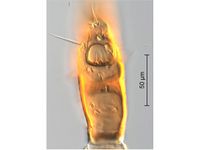Haemaphysalis longicornis
| Literature database |
|---|
| 157 articles sorted by: |
| • year (descending) |
| • research topics |
| • countries/regions |
| • list of natural enemies |
Haemaphysalis longicornis Neumann, 1901 - (bush tick, Asian longhorned tick)
This tick is native to eastern Asia, and has been introduced into Australia and parts of the Pacific. It has been further reported from North America since 2017 (Rainey et al., 2018). It may bite humans and is a vector of various pathogens like the Lyme disease (Borrelia burgdorferi), Theileria, Coxiella, Babesia, as well as bunyaviruses.
H. longicornis has a wide host range and feeds on a variety mammals and birds. The development involves three hosts. Males are rare and reproduction is usually by parthenogenesis. The egg stage can last up to 3 months. Larvae, nymphs, and adults feed for about one week before dropping to the ground for moulting, egg laying and searching for a new host. They can survive for more than 200 days without feeding.
For a review see Schappach et al. (2020).
- Other images of Haemaphysalis longicornis (PaDIL - click to enlarge)





